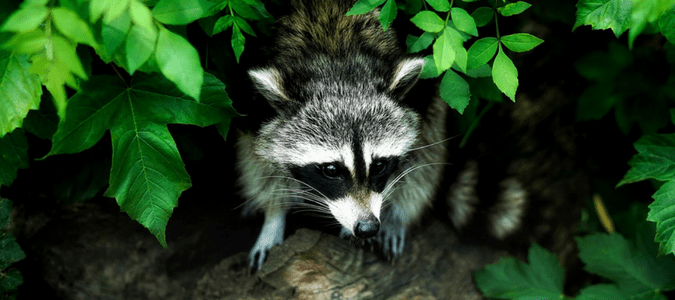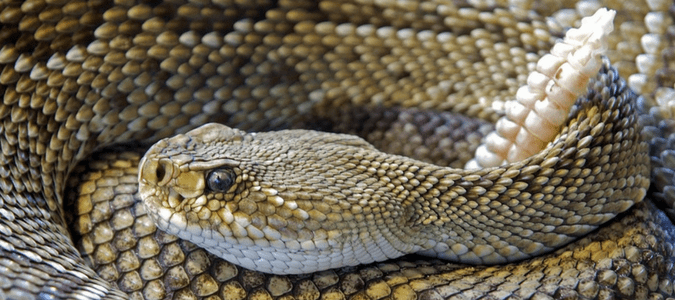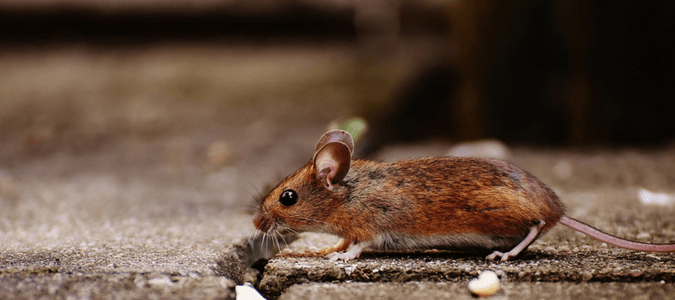
Whether their presence pops into your mind when thinking about the Lone Star state or not, Texas is home to abundant rodents and wildlife. Houston is no different. Our city is one of the state’s most populated and diverse wild animal ecosystems. The greater Houston area offers a combination of lush outdoors, bayous, and urban dwellings, which serve as the habitat for many rodents and wildlife.
Types of Rodents and Wildlife in Houston
One thing is seeing rodents or other types of wildlife when you are out and about. Spotting one of these animals in your yard will likely produce an entirely different reaction. Learn more about the types of rodents and wildlife that might make it into your outdoor spaces and the steps you can take to ensure they get out—and stay out.
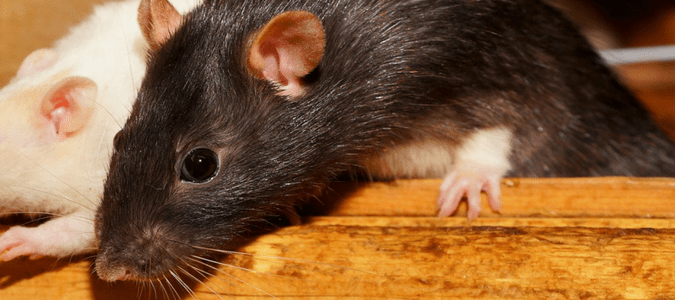
Roof Rats
Rats are much larger than mice, so you’ll know the difference when you see one. Roof rats (sometimes called black rats) can grow about seven to 10 inches long and are black-bodied with long tails. And as their name implies, they often find shelter in the insulation of your attic or roof. Their preferred diet includes fresh fruit, vegetables, seeds, and nuts, but like most other rodents, they will eat just about anything, including meats and grains.
How to Get Rid of Roof Rats
To remove roof rats from your home, be sure all food sources are secured and any above-ground entryways, like chimneys or voids in your ceilings, are closed off. Remove possible nesting sites by elevating woodpiles and garbage cans above the ground and keeping your yard well-manicured.
Norwegian Rats
Norwegian rats (sometimes called brown rats) are more extended and fatter than the roof rat and are often lighter in color. Unlike the roof rat, the Norwegian rat prefers to make its home in basements or in burrows under sidewalks or buildings. They aren’t great climbers. Their diet includes plant and animal products, but they prefer plants and grains and require substantial water to survive. If you find them in your basement or on the ground level of your home, you’ll want to remove them quickly. These rats are known to carry various diseases, including the bubonic plague.
How to Get Rid of Norwegian Rats
You can keep brown rats away from your property with the same methods to keep roof rats away. First, eliminate food sources by cleaning up spills; storing human, pet, and bird food in tightly-sealed containers; keeping your yard neat and tidy to remove potential nesting sites and sealing any entry points around your windows, doors, near appliances, and in vents and ductwork.
The House Mouse
House mice are grayish-brown with a pointed nose, large ears, and slender bodies. They are smaller than rats—about 1 to 2 inches long. Their preferred diet includes seeds, cereal grains, and sweets, but they will eat just about anything. The house mouse can live its entire life inside buildings, nesting in ceiling voids, storage boxes, and walls. They can also make homes under appliances and in your furniture, too. Like other mouse species, this species can nibble and gnaw through wires, boxes, and other everyday household products. You may have an infestation if you see signs of chewing and droppings.
How to Get Rid of House Mice
To eliminate house mice from your home, make sure all openings–even those as small as a ¼ inch across–are closed off, and be sure to seal all food in your home.
The Deer Mouse
The deer mouse has brown fur, a pointed nose, small ears, and short, brown whitetails and bellies. These mice are omnivorous, so they eat various plants and animals like insects, seeds, fruits, nuts, and flowers. Deer mice are small in size, averaging about 6 inches in length, and you’ll typically find them living in hollow trees, wood piles, old squirrel nests, or beneath trees or shrubs. While they prefer rural locations, they may enter your home during the cooler months, making their home in cabinets or unused furniture. Spotting just one in your home could indicate an infestation, though. If you do find a nest or droppings, don’t touch it with your bare hands. Deer mice are some of the primary carriers of the Hantavirus and Lyme disease.
How to Get Rid of Deer Mice
The best way to keep deer mice away is through exclusion measures—namely, keeping them out of your home in the first place. Many of the same measures to control other types of rats and mice are also effective for deer mice.
Raccoons
While raccoons prefer brushy or wooded areas, typically near bodies of water like streams, lakes, or swamps, they can live practically anywhere–including urban dwellings. Raccoons are well-adapted to human life and habitats, and in many cases, choose to live in urban dwellings because these environments, and the humans living there, provide ample resources like food, water, and shelter.
Raccoons are nocturnal animals, and most people notice their presence from the noise and mess they make while rummaging through their outdoor garbage cans for food. Their diet includes fruits and nuts, small rodents, bird eggs, insects, carrion, and human garbage. Raccoons are curious, intelligent, and robust and often do just about anything to find food and shelter, sometimes breaking into roofs and attics to find a safe place to stay.
How to Rid Your Property of Raccoons
If you find raccoons on your property, you’ll want to take appropriate measures to remove them and keep them away. They are a nuisance, and raccoons can carry many diseases, like rabies.
The first thing you’ll want to do is limit possible food sources. Be sure outdoor trash cans are tightly sealed and the garbage bag is tied securely to reduce the odor. Similarly, keep pet food in a secure area with a tightly sealed lid. And while we don’t want to suggest you remove any bird feeders you may have, it might be worth considering complete removal for some time while you rid your home of raccoons.
You’ll also want to secure your home’s entryways. If your home has a chimney, install a proper cover and be sure all vents, windows, and crawl spaces are covered. Finally, maintain a well-kept lawn and remove any areas that could foster nesting, like wood piles, old appliances, and abandoned projects.
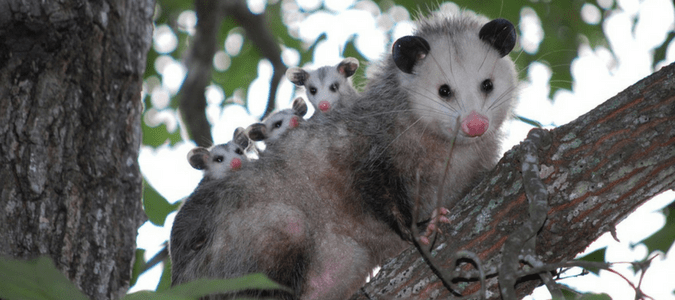
Opossums
Did you know that opossums are the only North American marsupials? Houston is one place these animals like to call home. What isn’t so lucky is that they cause quite a headache if they make their way onto your property.
Opossums, or possums, are like raccoons in many ways, especially regarding their diet. As omnivores, they will eat most foods, including your garbage. That means it’s not uncommon to find them rummaging through your trash at night or to find a mess near your home in the morning. They can also cause damage inside your home, as many seek shelter inside a shed, under your porch or floorboards, and, in most cases, your attic.
How to Get Rid of Opossums
If you find a possum on your property, you can do a few things to prevent it from returning. Remove any food source by securing your garbage and keeping a well-manicured lawn. You can also keep a backyard light on at night. Since they are nocturnal animals, the bright light might deter them from your property.
Snakes
Four species of venomous snakes are found in the U.S., and according to the City of Houston, all four are found here in Houston. These include the Cottonmouth (Water Moccasin), Copperhead, Coral Snakes, and Rattlesnakes.
How to Get Rid of Snakes
Preventing snakes from making their home on your property is similar to how you might deter rodents from building nesting sites. Keep undergrowth to a minimum and seal entry points to your home. Remove wood and rock piles from your yard and cut back shrubs and dense foliage.
The Cottonmouth Snake
The Cottonmouth Snake can be dark brown, olive-brown, olive green, or solid black and have broad, dark marks along their bodies. They average about 3 ½ feet long and prefer to build in or near swamps, marshes, rivers, ponds, and streams. Its diet includes fish, small mammals, birds, and amphibians. And while bites do happen if the snake feels threatened, cottonmouth snakes rarely bite humans.
The Copperhead Snake
Copperhead Snakes have reddish-brown crossbands on a lighter-colored body. Newborns have bright yellow tail. There are three subspecies in Texas, too: the Southern Copperhead, the Broad-banded Copperhead, and the Trans-Pecos Copperhead. While they prefer to live in wooded areas or near ponds or streams, they can also make their homes in garden mulch, compost piles, under decaying stumps or wood piles, or under abandoned building debris. During cooler months, copperheads enjoy basking in the sunlight; during summer, they only become active at night.
A copperhead’s bite is dangerous and vicious. If you find this species on your property, stay away and call a professional to remove it.
The Coral Snake
You’ll be able to notice a coral snake quickly due to its brightly colored body. The distinct pattern of black, yellow, and red indicate it’s a venomous snake–they have the second most potent venom of any snake. Usually about 2 ½ feet or smaller, this snake has a slender body and small head. The species found in Texas like to live under rocks or burrow into sand or soil, sometimes in suburban areas. Their diet consists of lizards and other small, smoothed-scaled snakes.
The Rattlesnake
Texas is home to two more primitive groups of rattlesnakes: the Western Massasauga and the Desert Massasauga. In total, Texas has eight types of rattlesnakes, including western diamondback rattlesnake, timber rattlesnake, prairie rattlesnake, Mojave rattlesnake, blacktail rattlesnake, western rattlesnake, and pygmy rattlesnake. Their most distinguishing feature is the rattle at the end of their tails.
Trust ABC To Remove Rodents & Wildlife
While there are several other rodents and wildlife in Houston, there’s never a reason to worry. Our ABC Home & Commercial Services team can provide you and your family with the tools and knowledge to ensure your home is pest and rodent-free. Whether you spot a mouse in your home, a raccoon in your trash, or a snake in your garden, our team has you covered.
